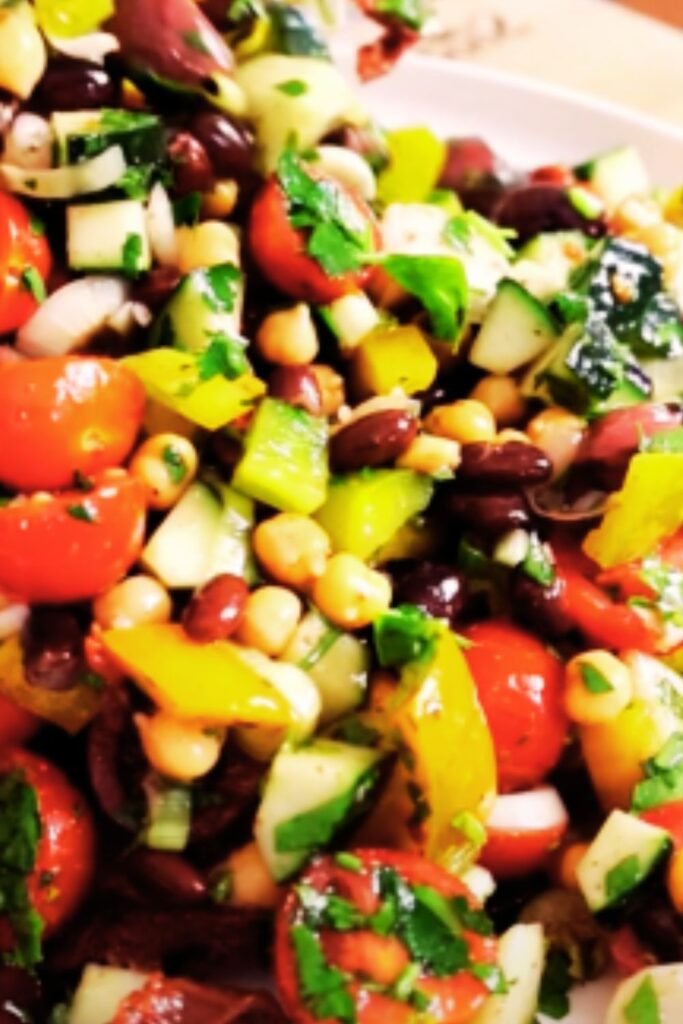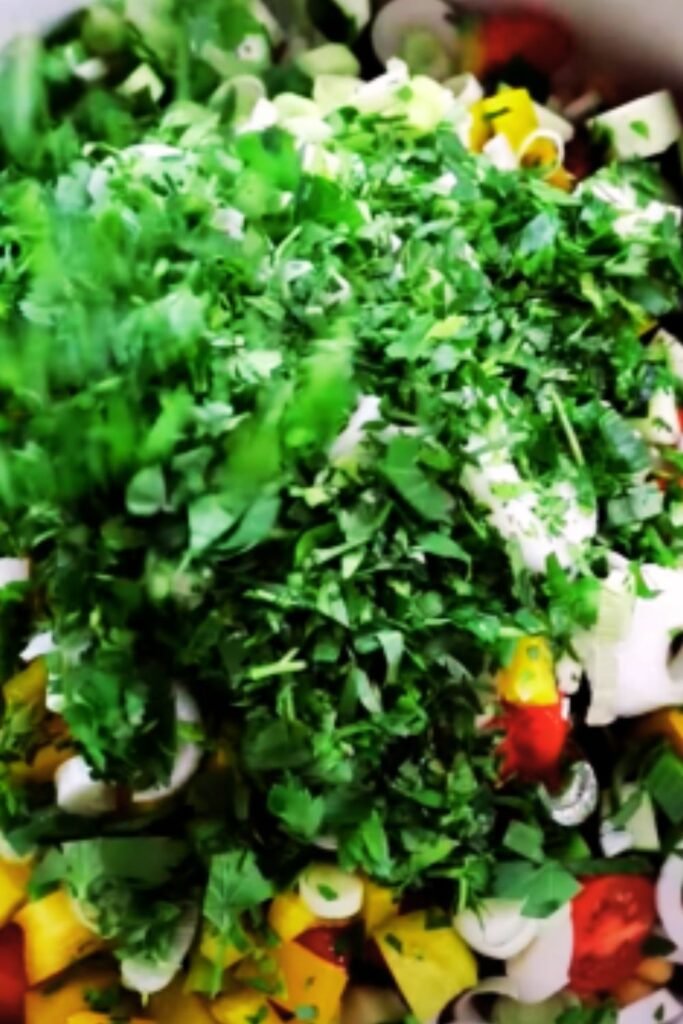There’s something magical about Mediterranean cuisine that instantly transports you to sun-soaked shores and azure seas. As someone who’s spent years perfecting recipes from this region, I’ve come to appreciate how a simple Mediterranean salad can become the star of any dining experience. Today, I’m sharing my comprehensive guide to creating the perfect Mediterranean salad that balances tradition with modern twists.
The Heart and Soul of Mediterranean Cuisine
Mediterranean salad isn’t just a dish—it’s a celebration of freshness, simplicity, and vibrant flavors that captures the essence of Mediterranean culture. Having traveled extensively throughout Greece, Italy, Spain, and other countries bordering the Mediterranean Sea, I’ve discovered that the best salads from this region share a common philosophy: let quality ingredients speak for themselves.
What makes a Mediterranean salad truly special is its foundation in the Mediterranean diet—widely recognized as one of the healthiest eating patterns in the world. The diet emphasizes plant-based foods, olive oil, and moderate consumption of dairy, fish, and poultry. When I create a Mediterranean salad, I’m not just preparing a delicious meal; I’m embracing a centuries-old approach to healthy eating that has stood the test of time.
Essential Ingredients for an Authentic Mediterranean Salad
The beauty of Mediterranean salad lies in its versatility and adaptability, but certain ingredients are non-negotiable if you want to capture that authentic Mediterranean flavor profile:
Fresh Vegetables and Greens:
- Crisp romaine or butter lettuce
- Juicy tomatoes (preferably heirloom or vine-ripened)
- Cool, refreshing cucumber
- Colorful bell peppers
- Red onions for a sharp bite
- Kalamata olives for rich, briny flavor
Cheese Options:
- Feta cheese (traditional Greek option)
- Halloumi (excellent grilled addition)
- Fresh mozzarella (for an Italian twist)
Protein Sources:
- Chickpeas for plant-based protein
- Grilled chicken for a hearty addition
- Wild-caught salmon or tuna for omega-3 fatty acids
- Boiled eggs for vegetarian options
Essential Herbs and Seasonings:
- Fresh oregano
- Fragrant basil
- Bright parsley
- Mint for a refreshing note
- Za’atar for Middle Eastern influence
- Sumac for tangy depth
The Foundation of Mediterranean Flavor:
- Extra virgin olive oil (the highest quality you can afford)
- Fresh lemon juice
- Aged balsamic vinegar (optional)
- Sea salt and freshly ground black pepper

The Science Behind Mediterranean Salad’s Health Benefits
I’ve always been fascinated by how something as delicious as a Mediterranean salad can also be incredibly good for you. Let’s examine the impressive nutritional profile and health benefits:
| Ingredient | Key Nutrients | Health Benefits |
|---|---|---|
| Extra Virgin Olive Oil | Monounsaturated fats, Vitamin E, Polyphenols | Reduces inflammation, Supports heart health, Antioxidant protection |
| Tomatoes | Lycopene, Vitamin C, Potassium | Cancer prevention, Immune support, Heart health |
| Cucumbers | Water, Vitamin K, Antioxidants | Hydration, Bone health, Anti-inflammatory |
| Bell Peppers | Vitamin C, Vitamin A, Carotenoids | Immune boosting, Eye health, Antioxidant protection |
| Feta Cheese | Calcium, Protein, Probiotics | Bone health, Muscle maintenance, Gut health |
| Kalamata Olives | Monounsaturated fats, Vitamin E, Iron | Heart health, Cell protection, Blood health |
| Chickpeas | Protein, Fiber, Complex carbs | Sustained energy, Digestive health, Blood sugar regulation |
| Fresh Herbs | Vitamin K, Vitamin A, Antioxidants | Anti-inflammatory, Immune support, Detoxification |
Research published in the Journal of the American Heart Association has shown that regular consumption of Mediterranean diet components can reduce the risk of cardiovascular disease by up to 25%. When I incorporate these ingredients into my salads, I’m not just creating a tasty dish—I’m making a conscious choice for better health.
Classic Mediterranean Salad Recipe
After years of experimentation, I’ve developed what I consider the perfect basic Mediterranean salad recipe. This serves as a wonderful foundation that you can customize based on seasonality and preference.
Ingredients (Serves 4):
- 4 cups mixed greens (romaine and butter lettuce work best)
- 2 medium tomatoes, cut into wedges
- 1 English cucumber, sliced into half-moons
- 1 red bell pepper, thinly sliced
- 1/2 red onion, thinly sliced
- 1 cup Kalamata olives, pitted
- 200g feta cheese, cubed or crumbled
- 1 cup cooked chickpeas (drained and rinsed if using canned)
- 1/4 cup fresh parsley, chopped
- 2 tablespoons fresh mint, chopped
- 1 tablespoon fresh oregano, chopped
For the Dressing:
- 1/3 cup extra virgin olive oil
- 3 tablespoons fresh lemon juice
- 1 garlic clove, minced
- 1 teaspoon Dijon mustard
- 1 teaspoon honey (optional)
- 1/2 teaspoon dried oregano
- Salt and freshly ground black pepper to taste
Preparation Method:
- Wash and thoroughly dry all fresh produce. I’ve learned that excess water dilutes the dressing and creates a soggy salad.
- In a large salad bowl, combine the mixed greens, tomatoes, cucumber, bell pepper, and red onion.
- Scatter the Kalamata olives, feta cheese, and chickpeas over the vegetables.
- In a small bowl, whisk together all dressing ingredients until emulsified. The mustard helps bind the oil and lemon juice together for a smooth, cohesive dressing.
- Just before serving, drizzle the dressing over the salad and toss gently to coat all ingredients. I always dress the salad at the last minute to maintain optimal texture.
- Finish by sprinkling the fresh herbs on top and provide additional feta cheese on the side for those who desire more.
Regional Variations of Mediterranean Salad
One aspect I love about Mediterranean cooking is how each region adds its unique twist to classic dishes. Here are some authentic regional variations of Mediterranean salad that I’ve encountered in my culinary travels:
Greek Horiatiki (Village Salad)
The quintessential Greek salad omits lettuce entirely, focusing instead on chunks of ripe tomatoes, cucumbers, onions, and bell peppers, topped with a substantial slice of feta and dressed simply with olive oil and oregano. When I visited a small taverna in Santorini, the owner explained that traditional Greek salads never include lettuce—a revelation that changed my approach to Mediterranean salads forever.
Spanish Ensalada Mixta
This Spanish variation includes boiled eggs and tuna, creating a more substantial dish that can serve as a complete meal. The dressing often incorporates sherry vinegar for a distinctive flavor profile that’s slightly sweeter than other Mediterranean varieties.
Italian Panzanella
This Tuscan bread salad transforms day-old bread into a delicious component by soaking it in olive oil and vinegar along with tomatoes, cucumbers, and basil. I learned this recipe from an elderly woman in Florence who insisted that the bread must be at least a day old to achieve the perfect texture—neither too soggy nor too firm.
Lebanese Fattoush
This Middle Eastern variant features toasted pita bread pieces and a distinctive sumac-seasoned dressing that provides a tangy, lemony flavor unlike any other Mediterranean salad. The addition of purslane, when available, adds a succulent texture and omega-3 boost that makes this variation particularly nutritious.

Tips for Perfect Mediterranean Salad Every Time
After countless Mediterranean salads made in my kitchen, I’ve developed these fool-proof tips that elevate an ordinary salad to extraordinary:
Quality Ingredients Make All the Difference
- Tomatoes: Wait until they’re truly ripe and fragrant for maximum flavor. In winter, I opt for cherry or grape tomatoes, which tend to be sweeter when other varieties are out of season.
- Olive Oil: This is not the place to skimp. A high-quality, cold-pressed extra virgin olive oil makes a remarkable difference in the final flavor profile. I recommend an olive oil with a harvest date printed on the bottle to ensure freshness.
- Feta Cheese: Look for authentic Greek feta made from sheep’s milk or a sheep and goat milk blend. It should be stored in brine, not pre-crumbled in a container, for the best texture and flavor.
Preparation Techniques
- Salt the Tomatoes Ahead: I often salt my sliced tomatoes 15 minutes before assembling the salad, allowing them to release some juices. This intensifies their flavor and creates the beginning of a delicious dressing.
- Quick-Pickle the Onions: Soaking sliced red onions in ice water for 10 minutes removes the harsh bite while maintaining their crisp texture. Alternatively, marinate them briefly in a bit of the dressing to soften their flavor.
- Layer Instead of Tossing: For a more impressive presentation, try layering the ingredients rather than tossing them together. This creates a beautiful visual effect and allows diners to see all the components.
Storage and Make-Ahead Strategies
If you need to prepare components in advance, here’s my strategy:
- Wash and prepare all vegetables up to 24 hours ahead, storing them separately in airtight containers lined with paper towels.
- Make the dressing up to 3 days ahead and store in a sealed jar in the refrigerator. Bring to room temperature and shake well before using.
- Assemble the salad no more than 30 minutes before serving for optimal freshness and texture.
Creative Mediterranean Salad Variations for Every Season
The Mediterranean diet emphasizes seasonal eating, and I’ve developed these seasonal variations to make the most of what’s available throughout the year:
Spring Mediterranean Salad
- Base: Tender spring greens and butter lettuce
- Add: Asparagus, fresh peas, young radishes, mint, and soft goat cheese
- Protein: Grilled spring lamb or seared halloumi
- Dressing: Lighter lemon-herb vinaigrette with fresh dill
Summer Mediterranean Salad
- Base: Ripe heirloom tomatoes and cucumbers
- Add: Stone fruits (like peaches or nectarines), fresh basil, and burrata
- Protein: Grilled shrimp or cold poached salmon
- Dressing: Simple olive oil and balsamic glaze
Fall Mediterranean Salad
- Base: Arugula and radicchio
- Add: Roasted butternut squash, pomegranate seeds, toasted walnuts, and aged pecorino
- Protein: Roasted chicken or chickpeas
- Dressing: Pomegranate molasses vinaigrette with warming spices
Winter Mediterranean Salad
- Base: Belgian endive and baby kale
- Add: Blood oranges, fennel, pine nuts, and oil-cured olives
- Protein: Tuna conserva or white beans
- Dressing: Orange-infused olive oil with mint and garlic
Serving Suggestions and Complete Meal Ideas
A Mediterranean salad can be a versatile component of various meal plans. Here are my favorite serving suggestions:
As a Starter
Serve a smaller portion of Mediterranean salad before a main course of grilled fish or roasted lamb. The bright, acidic flavors prepare the palate for the meal to come.
As a Main Course
Transform your salad into a complete meal by adding:
- Grilled chicken or salmon
- Hard-boiled eggs and tuna
- Falafel or grilled halloumi
- Quinoa or farro for complex carbohydrates
As a Side Dish
Pair a simple Mediterranean salad with:
- Grilled kebabs or souvlaki
- Roasted vegetables and hummus
- Fresh pita bread or focaccia
- Sparkling water with lemon or mint
For Special Occasions
For entertaining, I love creating a Mediterranean salad bar where guests can customize their own salads. I arrange individual components in separate bowls and provide various dressings. This interactive approach has been a hit at my dinner parties and casual gatherings alike.

Troubleshooting Common Mediterranean Salad Issues
Even experienced cooks sometimes encounter challenges with Mediterranean salads. Here are solutions to common problems:
Problem: Soggy Salad
Solution: Always thoroughly dry greens after washing (a salad spinner is invaluable here). Dress the salad immediately before serving, not in advance. If making ahead, keep the dressing separate until the last minute.
Problem: Bitter Olives
Solution: If your olives taste too bitter, soak them in cold water for 30 minutes to remove some of the brine. For a quicker fix, mix them with a teaspoon of honey before adding to the salad.
Problem: Overwhelming Onion Flavor
Solution: Soak sliced onions in ice water for 10-15 minutes, then drain and pat dry before adding to your salad. This preserves the crunch while tempering the harsh bite.
Problem: Bland Salad
Solution: Mediterranean salads rely on the quality of ingredients and proper seasoning. Make sure to use enough salt (preferably sea salt) and fresh herbs. A pinch of sumac or za’atar can also instantly elevate flavor.
Sustainable and Ethical Considerations
As a passionate advocate for sustainable eating, I believe in making conscious choices when creating Mediterranean salads:
- Source Locally When Possible: While traditional Mediterranean ingredients may come from far away, adapting the spirit of the diet with local produce reduces carbon footprint and supports local farmers.
- Consider Sustainable Seafood: If adding fish to your salad, choose options certified by organizations like the Marine Stewardship Council or Seafood Watch.
- Reduce Food Waste: Use vegetable scraps for stock, stale bread for croutons, and herb stems in dressings to minimize waste.
- Choose Ethical Olive Oil: Look for olive oil from producers who practice sustainable farming and fair labor practices. Many small producers list their harvesting and production methods on the label.
Questions & Answers
Q: Can I make Mediterranean salad ahead of time for a party?
Yes, but with some strategic preparation. Wash and chop all vegetables up to 24 hours ahead, storing them separately in the refrigerator. Prepare the dressing up to three days in advance. Assemble the salad no more than 30 minutes before serving, leaving the dressing separate until just before presentation. For buffet-style service, consider layering the ingredients rather than tossing them—this creates an impressive visual while preventing the bottom ingredients from becoming soggy.
Q: How can I make my Mediterranean salad more substantial for a main course?
Transform your salad into a complete meal by adding protein sources like grilled chicken, salmon, or halloumi cheese. Plant-based options include chickpeas, lentils, or toasted nuts. Adding cooked ancient grains like farro, quinoa, or bulgur wheat not only adds heartiness but also introduces complex carbohydrates that provide sustained energy. For a traditional approach, serve with warm pita bread on the side.
Q: What can I substitute for feta cheese if I’m dairy-free?
For a dairy-free alternative that still provides the salty, tangy element that feta brings, try marinated tofu crumbles. Firm tofu crumbled and marinated in lemon juice, nutritional yeast, herbs, and a touch of white miso creates a surprisingly similar flavor profile. Another excellent option is dairy-free almond-based feta alternatives now available in many specialty stores. For a completely different but complementary approach, add extra olives and capers to compensate for the missing salty element.
Q: How long will Mediterranean salad keep in the refrigerator?
An undressed Mediterranean salad can be stored in an airtight container in the refrigerator for up to 24 hours, though the vegetables will begin to lose their crispness after that point. Once dressed, the salad should be consumed within 2-3 hours for optimal texture and flavor. If you know you’ll have leftovers, reserve a portion without dressing and store components separately. The dressing itself will keep in the refrigerator for up to a week in a sealed container.
Q: Can I use dried herbs instead of fresh in my Mediterranean salad?
While fresh herbs provide the vibrant flavor that makes Mediterranean salads exceptional, dried herbs can work in a pinch with some adjustments. Use about one-third the amount of dried herbs compared to fresh (e.g., 1 teaspoon dried oregano for 1 tablespoon fresh). Dried herbs work best in the dressing where they have time to rehydrate and release their flavors. For the salad itself, consider alternatives like adding lemon zest or sumac to brighten the flavor profile if fresh herbs aren’t available.
Q: What’s the difference between Greek salad and general Mediterranean salad?
Traditional Greek salad (Horiatiki) specifically contains tomatoes, cucumbers, onions, Kalamata olives, and a large slice of feta cheese placed on top rather than crumbled throughout. It never includes lettuce and is dressed simply with olive oil, oregano, and sometimes a splash of red wine vinegar. Mediterranean salad is a broader term that can incorporate elements from various countries bordering the Mediterranean Sea, often including leafy greens, a wider variety of vegetables, different cheese options, and more complex dressings.
Mediterranean Salad: A Lifestyle, Not Just a Recipe
As I’ve deepened my relationship with Mediterranean cooking over the years, I’ve come to understand that the Mediterranean salad represents much more than just a healthy meal option—it embodies a philosophy about food and life. The emphasis on fresh, seasonal ingredients, minimal processing, and communal eating reflects values that extend beyond nutrition.
When I prepare a Mediterranean salad, I’m not simply following a recipe—I’m participating in a centuries-old tradition that celebrates the connection between food, health, and community. The vibrant colors of the vegetables, the aromatic herbs, and the simple yet flavorful dressing remind me to appreciate the inherent qualities of ingredients rather than masking them with heavy sauces or complicated techniques.
I encourage you to approach Mediterranean salad-making not as a strict formula but as an opportunity for creative expression that changes with the seasons and reflects your personal taste. Start with the basic framework I’ve provided, then adapt and experiment as you discover your preferences. The true spirit of Mediterranean cooking lies in this adaptability and respect for ingredients—values that can transform not just your salads, but your entire approach to eating.
Whether you’re preparing a quick lunch for yourself or hosting a dinner party for friends, the Mediterranean salad offers endless possibilities for nourishing both body and soul. As the Mediterranean proverb suggests, “Where there is good food, there is happiness”—and I can think of few dishes that deliver more happiness than a thoughtfully prepared Mediterranean salad shared with those you love.


